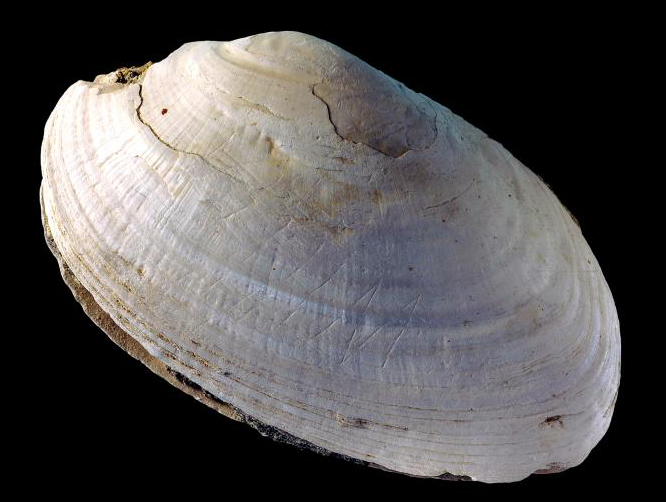


Shell may be oldest evidence of geometric art: our Homo erectus ancestors may have been smarter and more creative than we thought.

A line etched on a fossil mussel shell may be the oldest evidence of geometric art. Image: Wim Lustenhouwer
An online article by Brandon Keim for the National Geographic - World's Oldest Art Identified in Half-Million-Year-Old Zigzag - questions whether our Homo erectus ancestors may have been smarter and more creative than we thought.
A zigzag engraving on a mussel's shell is raising questions about the defining human capacity: artistic creativity.
The earliest evidence of geometric art was dated from 70,000 to 100,000 years ago; scratched into rocks found in South African caves, the engravings signified behavioral modernity: Homo sapiens' unique cognitive journey into a world of abstraction and symbol.
However, the recent analysis of the shell excavated from a riverbank in Indonesia thought to at least 430,000 years old was not made by humans - Homo sapiens.
This artist appears to have been one of our ancestors, Homo erectus, not previously associated with artistic and symbolic behaviour.
Archaeologist Josephine Joordens of Leidens University in the Netherlands and colleagues published their findings in Nature.
The engraving belongs to a trove of fossils unearthed in 1891 by Dutch paleoanthropologist Eugene Dubois. Among them were the first specimens of what Dubois called Pithecanthropus erectus, later known as Homo erectus. Dubois, however, did not describe the engraving.
Joordens's group, which now numbers 21 researchers, has now dated the shell to between 430,000 and 540,000 years ago. They have ruled out alternative explanations for the engraving and for holes in other shells that suggest they were opened by a tool.
ORIGINS section:
http://www.bradshawfoundation.com/origins/index.php
Ice Age Art:
http://www.bradshawfoundation.com/sculpture/index.php
by Bradshaw Foundation
Wednesday 23 July 2025
by Bradshaw Foundation
Thursday 29 May 2025
by Bradshaw Foundation
Monday 03 February 2025
by Bradshaw Foundation
Monday 30 May 2022
by Bradshaw Foundation
Wednesday 19 January 2022
by Bradshaw Foundation
Thursday 06 January 2022
by Bradshaw Foundation
Tuesday 21 March 2023
by Bradshaw Foundation
Tuesday 07 February 2023
by Bradshaw Foundation
Thursday 19 May 2022
by Bradshaw Foundation
Monday 04 December 2023
by Bradshaw Foundation
Friday 30 June 2023
by Bradshaw Foundation
Thursday 06 April 2023
by Bradshaw Foundation
Friday 14 July 2023
by Bradshaw Foundation
Monday 22 November 2021
by Bradshaw Foundation
Tuesday 12 July 2016
by Bradshaw Foundation
Tuesday 26 November 2024
by Bradshaw Foundation
Monday 27 November 2023
by Bradshaw Foundation
Friday 07 October 2022
by Bradshaw Foundation
Wednesday 23 July 2025
by Bradshaw Foundation
Thursday 29 May 2025
by Bradshaw Foundation
Monday 03 February 2025
by Bradshaw Foundation
Monday 30 May 2022
by Bradshaw Foundation
Wednesday 19 January 2022
by Bradshaw Foundation
Thursday 06 January 2022
by Bradshaw Foundation
Tuesday 21 March 2023
by Bradshaw Foundation
Tuesday 07 February 2023
by Bradshaw Foundation
Thursday 19 May 2022
by Bradshaw Foundation
Monday 04 December 2023
by Bradshaw Foundation
Friday 30 June 2023
by Bradshaw Foundation
Thursday 06 April 2023
by Bradshaw Foundation
Friday 14 July 2023
by Bradshaw Foundation
Monday 22 November 2021
by Bradshaw Foundation
Tuesday 12 July 2016
by Bradshaw Foundation
Tuesday 26 November 2024
by Bradshaw Foundation
Monday 27 November 2023
by Bradshaw Foundation
Friday 07 October 2022
by Bradshaw Foundation
Tuesday 19 November 2024
by Bradshaw Foundation
Wednesday 22 May 2024
by Bradshaw Foundation
Friday 10 November 2023
Friend of the Foundation











